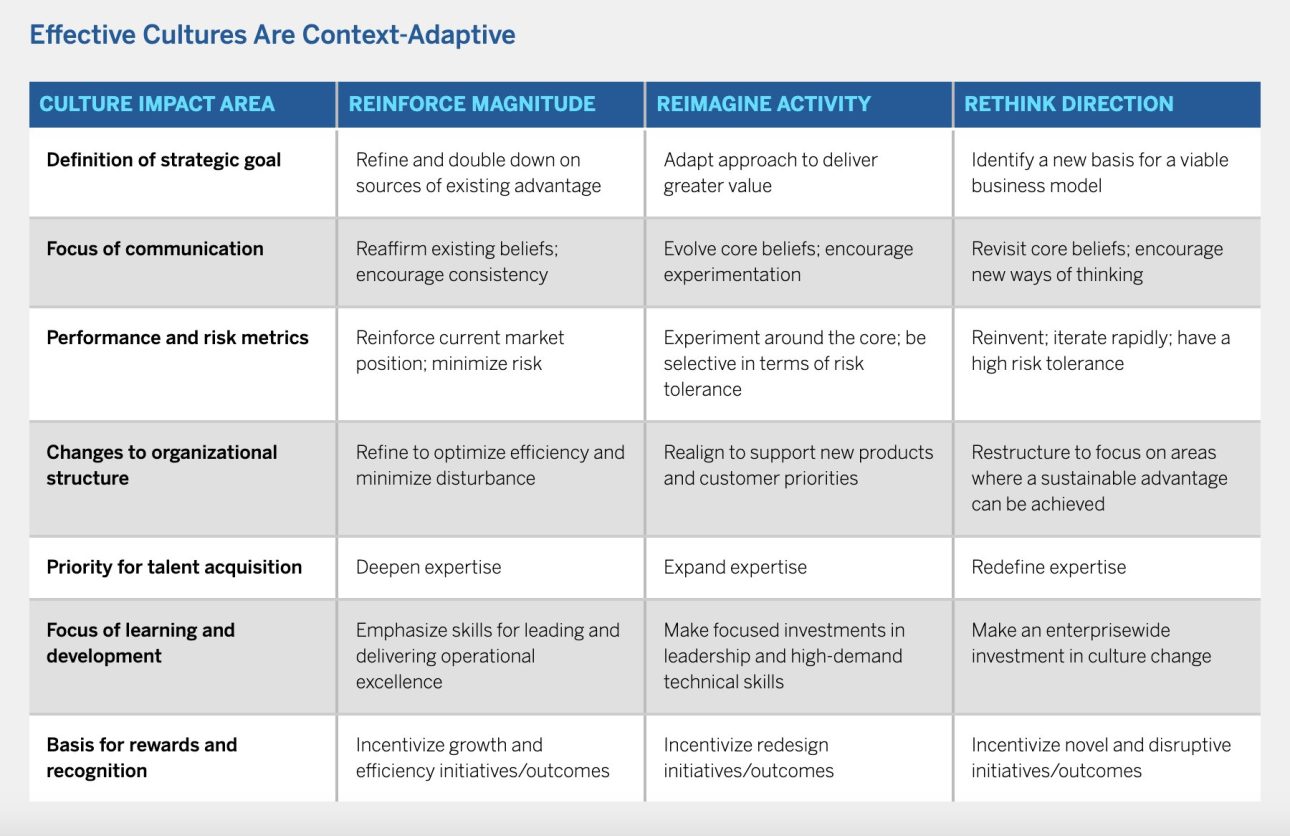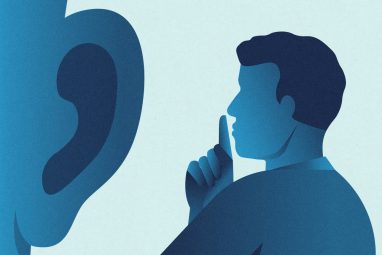The Role of Culture in Enabling Change
Leaders can shift their organization’s culture to better translate strategy into behavior and reinforce change priorities.
News
- Core42 and Qualcomm Launch Compass 2.0 to Boost AI Efficiency and Accessibility
- Data Debt Emerges as Core Business Issue for Enterprises
- Are Organizations Investing in AI Achieving Positive ROI?
- Are Increasing Breaches Due to the Cyber Skills Gap?
- What Are the Challenges Firms in the UAE and Saudi Arabia Face in GenAI Implementation?
- Enterprises See the Promise of Generative AI But Lack the Guardrails to Mitigate Operational Risks

MIT SMR
Culture is often described as “how we do things around here” — a passive reflection of legacy norms and behaviors. It’s more helpful to think of culture as the nervous system of an organization. In biology, the central nervous system is the pathway by which thoughts in our brains are translated into actions by our muscles, and how our experience of acting in the world updates our brain’s understanding of the world. In organizations, this means thinking of culture as the transmission mechanism by which a company both communicates its intended strategy to the front lines and receives feedback and intelligence from the field about whether the strategy is achieving the intended outcomes in the market.
This nervous system metaphor illuminates the factors behind two of the most common reasons given for business failure: “We had a great strategy but failed to execute it” (a failure in the communication from the center to the field) or “Our leaders surrounded themselves with people who were afraid to tell them how the business was really performing” (a failure to relay important feedback and intelligence from the field). Both are examples of the failure to create an effective transmission mechanism from thought to action and back again.
A strategic approach to culture involves an active effort to create the environment and infrastructure to promote the necessary information flow between strategy and execution — treating them as complementary components of purposeful doing. These tools can include town halls, customer site visits, postmortems on lost bids, employee engagement surveys and any number of other mechanisms that facilitate the exchange of valuable information about what is (or is not) working. These tools nurture a culture of contextual awareness and adaptability that enables the business to perform better in its current environment and to prepare for future success.
There are certain aspects of culture that are universally desirable and others whose value is more context-dependent. When Donald Sull and Charles Sull analyzed 1.4 million employee reviews on Glassdoor, they identified four key factors that contribute to a positive corporate culture (respect, leadership, compensation/benefits, and job security). But when organizational change is the imperative, this requires deliberately adding context-dependent factors to the culture.
The importance of adaptation has been the defining theme of our earlier articles about strategy, innovation, and leadership. To illustrate how different change objectives require different choices about culture, we’ll draw on the corporate human resources leadership experiences of one of the authors (Melanie Hughes) across her career. At three different companies, she used three different strategies first to determine the change need and then to identify the characteristics of an effective culture to operationalize this change priority.
Identify the Organization’s Change Priority
One of the most important — but often overlooked — responsibilities of HR is to analyze what aspects of the corporate culture are enabling the company to perform well in its current environment and what aspects are inhibiting its ability to act in the way and/or with the speed that the context requires.
The first step in this process is investigating the type of change that the business, unit, or team should be trying to achieve. As we described in “The Essence of Strategy Is Now How to Change,” there are three approaches to making such changes:
- Reinforce magnitude: Refine and deepen the actions that are contributing to high levels of relevance for key stakeholders and distinctiveness from competition.
- Reimagine activity: Refresh the approaches, channels, and tools being used to pursue the current strategy.
- Rethink direction: Reinvent the business model to deliver the levels of relevance and distinctiveness necessary for an economically viable business.
Based on its understanding of the desired form of change, HR can identify the mechanisms to achieve the desired results, which staff members are best placed to play the role of change agent (those tasked with infusing new elements into the culture), and who can play the role of culture carrier (demonstrating how these new elements can be integrated with the legacy elements of the culture that are being maintained).
We review each of the change types and what kinds of tools and actions can best enable each one, drawing from Hughes’s experiences as the chief administrative officer at Gilt Groupe and the chief human resources officer (CHRO) at Moody’s and Tribune Media.
Change Type 1: Reinforce Magnitude
Launched in 2007, New York-based Gilt Groupe was a pioneer of the luxury goods flash sale. The company was in hypergrowth mode from 2009 to 2012, when Hughes was the chief administrative officer: expanding from women’s clothing to offering menswear and travel as well, launching operations in Japan, raising capital at a valuation of more than $1 billion in 2011, and actively planning for an initial public offering. With Gilt Groupe as a recognized market leader in the fashion space and a preferred partner of luxury goods manufacturers, the change priority was to reinforce magnitude — that is, expand the actions that were making the company relevant and distinctive — by replicating the successful core business model in new categories.
The central challenge was determining how to combine the entrepreneurial, growth-focused orientation of the existing culture with the knowledge sharing and repeatable processes necessary to support expansion into multiple new categories and manage their different stages of development. Two of the key enablers of this change were revised messaging by the CEO in the company’s all-hands meetings and adjustments to the incentive schemes for executives and managers.
In both cases, the prior focus on growth alone was replaced by an emphasis on manageable growth, efficiency, and profitability. The CEO assumed the role of principal change agent, focusing on stories that celebrated costs avoided and efficiencies achieved, not just revenues won. The incentive programs were adjusted, with the focus on the performance of the individual businesses shifting instead to a balance of contributions to “Gilt corporate” and individual business performance. Specific individuals were identified as culture carriers because they had already demonstrated the behaviors of knowledge sharing, mentorship, and effective delegation — three key aspects of the new culture. These individuals were given increased responsibilities and promotions as visible signs of recognition (in addition to nonpublic compensation increases) to underscore the behaviors that the company now valued.
These actions paved the way for organizational changes that the previous culture would have resisted as bureaucratization infringing on the autonomy of the individual businesses. Instead, the centralization of certain services and infrastructure (such as marketing, development, finance, and recruiting) was accepted as the means to enable the businesses to scale faster.
Change Type 2: Reimagine Activity
The context of Hughes’s most recent role, as CHRO at Moody’s (2017 to 2021), was, in contrast, one in which reimagining activity was the appropriate stance, given the objective of innovating the approaches and tools being used to pursue the existing strategy. Moody’s comprised a highly successful but mature ratings business and a fast-growing analytics business. There was rising cultural tension as each organization championed the merits of its approach to risk, innovation, customers, and staffing. Recognizing the incompatibility of these modes of operating, the CEO and president of each business worked with HR leadership on a program designed to evolve the corporate culture while also establishing an operating infrastructure and a performance management system specifically designed to support the needs of Moody’s Analytics.
Several organizational initiatives were developed to support the change. Among them were expanding the corporate values to include elements such as speed and innovation (primarily associated with the analytics business) and to celebrate examples of those values in communications to employees and on investor calls. Leadership development programs were established to cross-train managers on the critical skills for each line of business and identify change agents who could cross-seed desired behaviors into each business. A new talent-planning process called Talent to Value identified the roles with the greatest strategic impact on each business and the skills required to perform those roles. This enabled leaders to understand which internal candidates were truly qualified for roles and where they needed to look for external talent to fill critical roles and support the new culture.
The CEO explicitly articulated a change from the previous “promote from within” culture, emphasizing the benefits of a broader and more diverse employee base to the performance of both businesses. These communications included LinkedIn posts from the CEO, signaling both internally and externally what was required to progress in the modern Moody’s. This messaging was reinforced by the publicity given to new hires and internal promotions, emphasizing how these employees embodied the desired skills and traits described in the Talent to Value effort.
Reimagining these activities supported the transition of Moody’s to a multibusiness firm with cultures, structures, and skills sets appropriate for each entity. The stock grew 60% in two years, reflecting a strong profit performance of the legacy Moody’s ratings business combined with a higher multiple attributed to the growth potential of the analytics business.
Change Type 3: Rethink Direction
Hughes’s time as CHRO at Tribune Media (2013 to 2016) represented an entirely different challenge. Tribune Media had gone through the largest media industry bankruptcy in U.S. history in 2008, and as it emerged from four years of bankruptcy proceedings in 2012, the priority was to rethink its direction by establishing a business based on viable economics. A creative and action-oriented CEO was recruited for this purpose. The company adopted a strategy to spin off the legacy print journalism assets into a separate company (Tribune Publishing), invest heavily to grow the digital media and content-creation capabilities of Tribune Media, and make selective acquisitions in the broadcast business to build the necessary economies of scale.
For a business that had been beaten down by years in the bankruptcy courts and a relentless focus on cost cutting, the new strategy necessitated a complete cultural reboot. Certain behavioral norms — aversion to risk, a focus on the short term, reluctance to take on additional responsibility — had become ingrained during the bankruptcy years and needed to be reset. The CEO and Hughes recruited a new executive team ready to establish the type of culture required to support the new strategy. They, in turn, brought in new leaders and employees to start to transform their teams. The leadership team worked together to identify “Trib traits” — the set of values and competencies that would encourage new behaviors, which included “curious and courageous,” “competing with passion,” and “exemplifying leadership.”
The Trib traits became the blueprint for recruiting new employees and for a new performance evaluation and rewards system. The latter now tied fully 50% of managerial bonuses to the demonstration of competencies, to emphasize that how things got done was as important as the outcome. (Historically, bonuses had been entirely based on financial results.) This shift was reinforced in newly established televised town halls, where the CEO spoke about doing the right thing rather than doing the thing right to give employees the license to venture away from the safe path and experiment with new ways of operating — as was appropriate for a business emerging from bankruptcy and competing in the dynamic environment of digital media and entertainment.
As the above cases illustrate, the enablers of cultural change vary according to the type of change that an organization is trying to achieve. The table below summarizes how the type of change needed informs a consistent set of culture actions to be taken.






